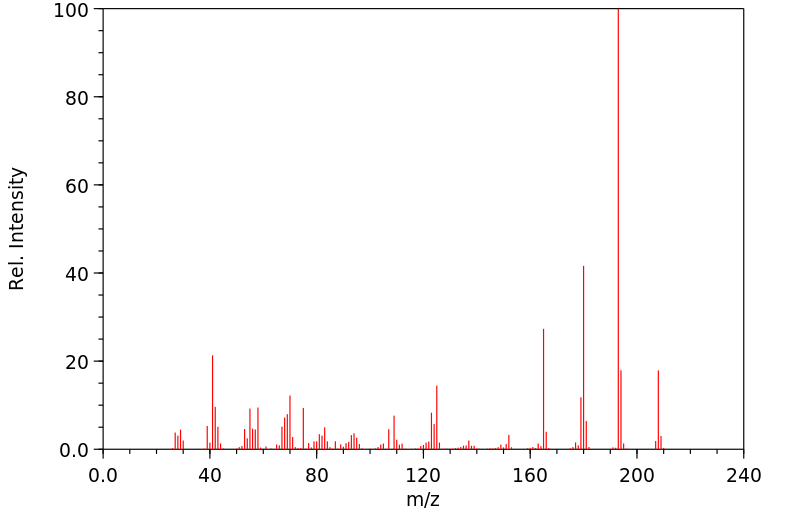1,2,3,4,4a,5,6,7-八氢-2,2,4a,7,7-五甲基萘啶 | 69340-58-5
中文名称
1,2,3,4,4a,5,6,7-八氢-2,2,4a,7,7-五甲基萘啶
中文别名
3,3,6,9,9-五甲基-2,10-二氮杂双环[4.4.0]癸-1-烯;1,2,3,4,4A,5,6,7-八氢-2,2,4A,7,7-五甲基萘啶
英文名称
3,3,6,9,9-pentamethyl-2,10-diazabicyclo[4.4.0]dec-1-ene
英文别名
1,2,3,4,4a,5,6,7-Octahydro-2,2,4a,7,7-pentamethyl-1,8-naphthyridine;2,2,4a,7,7-pentamethyl-3,4,5,6-tetrahydro-1H-1,8-naphthyridine
CAS
69340-58-5
化学式
C13H24N2
mdl
MFCD03225609
分子量
208.347
InChiKey
OEOPGVPCZRQSMQ-UHFFFAOYSA-N
BEILSTEIN
——
EINECS
——
-
物化性质
-
计算性质
-
ADMET
-
安全信息
-
SDS
-
制备方法与用途
-
上下游信息
-
文献信息
-
表征谱图
-
同类化合物
-
相关功能分类
-
相关结构分类
物化性质
-
密度:0.924 g/mL at 20 °C(lit.)
-
闪点:96 °C
计算性质
-
辛醇/水分配系数(LogP):2
-
重原子数:15
-
可旋转键数:0
-
环数:2.0
-
sp3杂化的碳原子比例:0.923
-
拓扑面积:24.4
-
氢给体数:1
-
氢受体数:1
安全信息
-
海关编码:2933990090
-
WGK Germany:3
上下游信息
反应信息
-
作为反应物:描述:1,2,3,4,4a,5,6,7-八氢-2,2,4a,7,7-五甲基萘啶 在 三氧化硫吡啶 作用下, 以 四氢呋喃 为溶剂, 反应 1.0h, 以88%的产率得到3,3,6,9,9-pentamethyl-10-sulfo-2,10-diazabicyclo<4.4.0>-1-decene参考文献:名称:Synthesis of 3-acylamino-4-hydroxymethyl-2-oxo-1-sulfoazetidines and related compounds.摘要:本文介绍了反式-3-乙酰氨基-4-羟甲基-2-氧代-1-磺酸基氮杂环丁烷 3a, b 和 4a, b 的两种对映体的合成。4- 羟甲基-2-氮杂环丁酮的对映体 7a 和 7b 被选作起始原料,后者由 L-苹果酸合成。为了在 N-1 位进行磺化,制备并使用了新的脒-N-磺酸 6。文中介绍了 4-乙酰氧甲基衍生物 22a, b 和 23a, b 的制备和抗菌特性。DOI:10.1248/cpb.32.1303
-
作为产物:描述:2,5-二甲基-2-(3-甲基-2-丁烯-1-基)-4-己烯腈 在 盐酸 、 sodium amide 作用下, 以 甲苯 、 苯 为溶剂, 反应 8.0h, 生成 1,2,3,4,4a,5,6,7-八氢-2,2,4a,7,7-五甲基萘啶参考文献:名称:Dworniczak, Miroslaw; Leffek, Kenneth T., Canadian Journal of Chemistry, 1990, vol. 68, # 10, p. 1657 - 1661摘要:DOI:
-
作为试剂:描述:tert-butyldimethyl(p-tolyloxy)silane 、 氟磺酰基氧基苯 在 1,2,3,4,4a,5,6,7-八氢-2,2,4a,7,7-五甲基萘啶 作用下, 以 乙腈 为溶剂, 反应 24.0h, 以10%的产率得到对甲酚参考文献:名称:基于 SuFEx 的多硫酸盐的合成摘要:在碱性催化剂存在下,芳族双(甲硅烷基醚)和双(氟硫酸盐)很容易形成高分子量的多硫酸盐。该反应在纯净条件下或在溶剂(如二甲基甲酰胺或N-甲基吡咯烷酮)中快速且良好地进行,以接近定量的产率提供所需的聚合物。这些聚合物比聚碳酸酯类似物更耐化学降解,并表现出优异的机械、光学和氧气阻隔性能。DOI:10.1002/anie.201403758
文献信息
-
Taming Ambident Triazole Anions: Regioselective Ion Pairing Catalyzes Direct N-Alkylation with Atypical Regioselectivity作者:Harvey J. A. Dale、George R. Hodges、Guy C. Lloyd-JonesDOI:10.1021/jacs.9b02786日期:2019.5.1of an organocatalytic methodology for ambident control in the direct N-alkylation of unsubstituted triazole anions. Amidinium and guanidinium receptors are shown to act as strongly coordinating phase-transfer organocatalysts, shuttling triazolate anions into solution. The intimate ion pairs formed in solution retain the reactivity of liberated triazole anions but, by virtue of highly regioselective控制环境亲核试剂对烷化剂的区域选择性是杂环化学中的一个基本问题。未取代的三唑特别具有挑战性,通常需要低效的逐步保护-去保护策略和预功能化方案。在此,我们报告了原型双基 1,2,4-三唑、1,2,3-三唑及其阴离子的烷基化,通过原位 1H/19F NMR、动力学模型、扩散有序 NMR 光谱、X 射线分析晶体学、高度相关的耦合簇计算 [CCSD(T)-F12、DF-LCCSD(T)-F12、DLPNO-CCSD(T)] 和 Marcus 理论。由此产生的机理见解允许设计一种有机催化方法,用于在未取代的三唑阴离子的直接 N-烷基化中进行环境控制。脒和胍受体显示出作为强协调相转移有机催化剂的作用,将三唑根阴离子穿梭到溶液中。在溶液中形成的紧密离子对保留了释放的三唑阴离子的反应性,但由于高度区域选择性的离子对,显示出完全反转(1,2,4-三唑)或显着增强(1,2,3-三唑)与母体阴离子相比。该方法允许一步直接获得
-
Are Oxazolidinones Really Unproductive, Parasitic Species in Proline Catalysis? – Thoughts and Experiments Pointing to an Alternative View作者:Dieter Seebach、Albert K. Beck、D. Michael Badine、Michael Limbach、Albert Eschenmoser、Adi M. Treasurywala、Reinhard Hobi、Walter Prikoszovich、Bernard LinderDOI:10.1002/hlca.200790050日期:2007.3and reactions of the oxazolidinone derived from proline and cyclohexanone. This oxazolidinone reacts (THF, room temperature) with the electrophiles β-nitrostyrene and chloral (=trichloroacetaldehyde), to give the Michael and aldol adduct, respectively, after aqueous workup (Scheme 5). The reactions occur even at −75° when catalyzed with bases such as 1,8-diazabicyclo[5.4.0]undec-7-ene (DBU) or EtN(i-Pr)2由脯氨酸和醛或酮形成的N,O-乙缩醛和N,O-缩酮衍生物(恶唑烷酮)如今已广为人知,在涉及脯氨酸催化的反应混合物中可检测到,它们被认为是“寄生死角” '。我们公开了在1970年代初期进行的实验的结果,并描述了有关脯氨酸和环己酮衍生的恶唑烷酮的分离,表征和反应的最新发现。该恶唑烷酮在水性处理后,与亲电体β-硝基苯乙烯和氯醛(=三氯乙醛)反应(THF,室温),分别得到迈克尔和醛醇加合物(反应路线5))。当使用碱,例如1,8-二氮杂双环[5.4.0]十一碳-7-烯(DBU)或EtN(i-Pr)2(DIPEA)(10%;表1)催化时,反应甚至在-75°时发生。。通过NMR(图1和3)和IR分析(图2和4)显示,与硝基烯烃的反应的主要可检测产物(在水解之前)再次是恶唑烷酮。当溶于羟基溶剂(例如MeOH,'六氟异丙醇'((CF 3)2 CHOH; HFIP),AcOH,CF 3 COOH)或溶于LiB
-
GLYCOSYLATED VALPROIC ACID ANALOGS AND USES THEREOF申请人:HEYMAN Norman S.公开号:US20130029924A1公开(公告)日:2013-01-31Glycosylated valproic acid and its analogs are provided. In some embodiments, the glycosylated valproic acid and its analogs have improved solubility and are ideal for drug delivery to treat a variety of diseases.
-
AsymmetricDiels-Alder Reactions of Neopentyl-Ether-Shielded Acrylates and Allenic Esters: Syntheses of (?)-Norbornenone and (?)-?-Santalene作者:Wolfgang Oppolzer、Christian Chapuis、Dominique Dupuis、Maodao GuoDOI:10.1002/hlca.19850680803日期:1985.12.18Starting from (+)- or (−)-camphor, the antipodal alcohols 14 and 18, respectively, have been prepared; the corresponding acrylates 15 and 19 underwent TiCl2(i-PrO)2-mediated Diels-Alder additions to cyclopentadiene to give adducts 20a and 22a respectively, with 95 % endo- and 99.2% πpH-face selectivities. Adduct 22a was converted to enantiomerically pure norbornenone 26. Addition of 1,3-butadiene to
-
PROCESS FOR PREPARING SAFINAMIDE申请人:MEDICHEM, S.A.公开号:US20210040033A1公开(公告)日:2021-02-11The present invention is related to a process for preparing safinamide and salts thereof, preferably safinamide methanesulfonate, with high yields and high enantiomeric and chemical purity without the need of using highly pure intermediates. The process of the present invention is suitable for the production of safinamide and its salts, preferably safinamide methanesulfonate, at industrial scale.
表征谱图
-
氢谱1HNMR
-
质谱MS
-
碳谱13CNMR
-
红外IR
-
拉曼Raman
-
峰位数据
-
峰位匹配
-
表征信息
同类化合物
(12羟基吲[2,1-b〕喹唑啉-6(12H)-酮)
黑暗猝灭剂BHQ-3,BHQ-3NHS
鸭嘴花酚碱
鸭嘴花碱酮;(S)-2,3-二氢-3,7-二羟基吡咯并[2,1-b]喹唑啉-9(1H)-酮
鸭嘴花碱酮
鸭嘴花碱盐酸盐
鲁米诺单钠盐
鲁米诺
骆驼蓬碱
颜料蓝64
颜料蓝60
顺式-卤夫酮
顺式-(喹喔啉-2-基)丙烯腈1,4-二氧化物
非奈利酮
青黛酮
雷替曲塞杂质1
阿法替尼杂质J
阿法替尼杂质I
阿法替尼杂质28
阿法替尼杂质18
阿法替尼杂质13
阿法替尼杂质
阿法替尼中间体
阿法替尼
阿法替尼
阿朴藏红
阿巴康唑
阿夫唑嗪杂质A
阿夫唑嗪杂质
阿夫唑嗪EP杂质C
阿夫唑嗪
阿喹司特
阿呋唑嗪杂质
阿呋唑嗪杂质
铜迈星
铁诱导细胞死亡激活剂
钠四丙基硼酸酯
酸性蓝98
酸性红101
酮色林醇
酞联氮基[2,3-b]酞嗪-5,14-二酮,7,12-二氢-
酞嗪-5-羧酸
酞嗪-2-氧化物
酚藏花红
酚嗪
酒石酸溴莫尼定
邻苯二甲酰肼
还原黄6GD
还原蓝6
达尼喹酮







